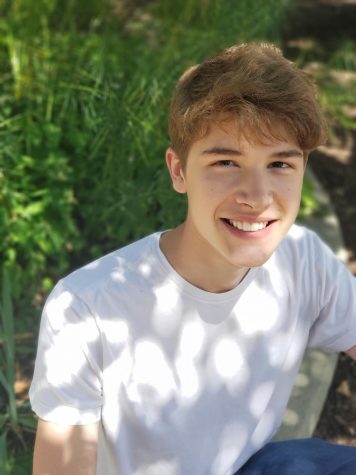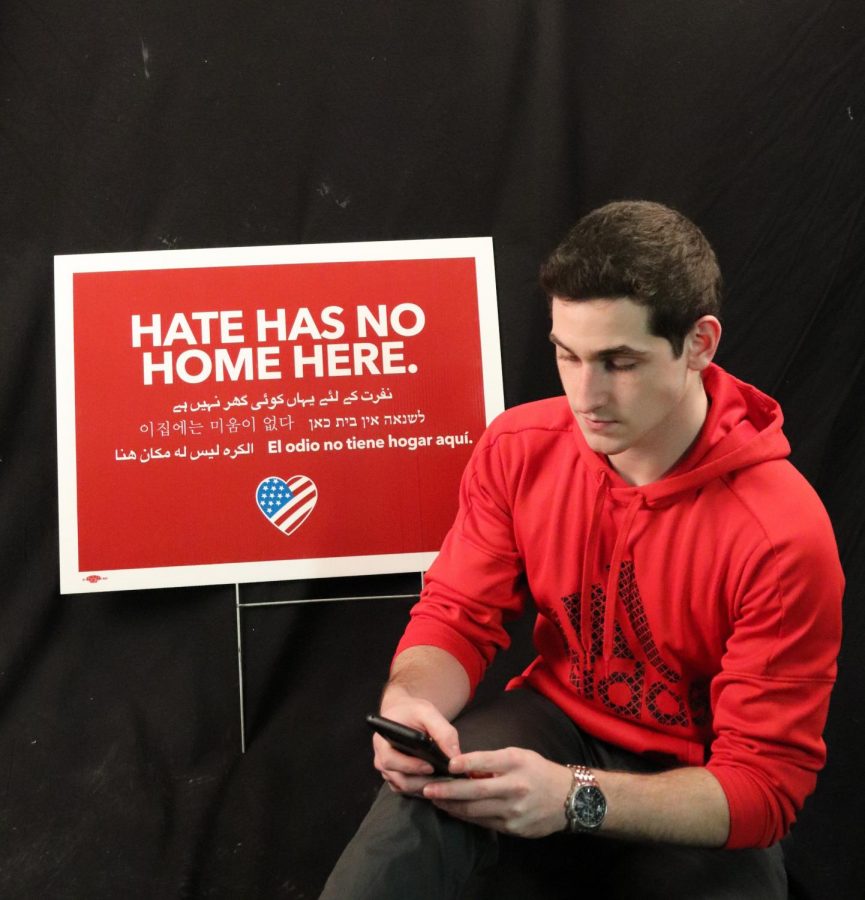Inundated with information
Students feel overwhelmed, struggle to respond
Photo by Ha
Nowadays over 65.8 percent of teenagers feel they are overexposed to the news around them, according to a Bear Facts survey of 351 students. With all of the tabs open on their phones, teenagers are struggling to close all the tabs in their mind.
With so much exposure to social media and 24-hour news cycles, teenagers today are more aware of the current events occurring around them, in comparison to teenagers from 20 years ago. In fact, 30.4 percent of students believe the 24-hour news cycle impacts them negatively.
“Most news outlets now have switched to 24-hour news cycles to meet the growing need to deliver the most immediate and compelling news at every hour of every day,” according to an article on axiapr.com, psychology website. “Given the constant need to fill the cycle with updates and fresh stories, the news media is often hungry for fresh meat.”
The growth in 24-hour news cycles forces teenagers to be more aware of their surroundings constantly, and exposes them to most of the world’s problems. The rise of technology has contributed to this dilemma because teenagers are able to carry 24-hour news with them in their pockets. Over 83 percent of students get their news from social media platforms and believe social media use has increased.
“Social media has become inescapable over the last decade. Social media is a powerful tool for regular people to spread information about world events and politics faster than before,” according to an article on Daily Collegian, professional publication.
The overexposure to news can be detrimental to teenagers’ and their developing minds. It creates a feeling of frustration among adolescents because of their inability to solve the array problems they are exposed to.
“There is the idea that overexposure to horrific images, from news reports in particular, could cause viewers to shut down emotionally, rejecting information instead of responding to it,” according to article on The Guardian, news website.
Inescapable Nature of News
“It just seems like you can’t escape it now is what it boils down to,” Victoria Foss, psychology and history teacher, said. “And I wonder, is it really the internet though or is it more. Our cell phones [20 years ago] didn’t have internet access yet – you couldn’t watch videos, and I worry about the amount of handheld devices we have and how that’s contributing to our anxiety.”
This anxiety is just one aspect of the impacts from constant news, Ryan Bohn, sophomore and self-proclaimed news hound, said. There are sweeping effects on the mind from the exposure to these tragedies, Bohn said, particularly among his peers.
“[Exposure] definitely causes a lot of stress and anxiety overall. A lot of students do feel legitimate stress even when things don’t necessarily have a direct impact on them when they hear about stuff like that on social media,” Bohn said. “It creates a less optimistic view of the world and your future when you know about the negative things that are constantly happening in the world.”
The impacts of this overload can vary between students, but one main impact may be a more pessimistic attitude, Adam Cupples, senior and current psychology student, said. The amount of negative stories being circulated on the news and social media, said Cupples, contributes to people seeing the world in a more negative light.
“[People] just have this very poor view of the world. And you know, in some cases it is justified. If it is some sort of man made tragedy, it just causes people to have a negative, more sorrowful outlook on the world around them,” Cupples said. “[This] is upsetting because [people in our generation will] have a very pessimistic attitude on how they go about their day and how they view their own life.”
As a result of this more attitude, students may feel frustrated or distressed over the present state of the world, and downsides of this stress may result in a lack of action, Cupples said.
“I feel like people are going to be less inclined to do something to solve a problem, or to donate, because I feel like their thought process would be ‘what’s the point, it’s just gonna happen later’,” Cupples said. “It’s just really unfortunate that people see all this and decide that the world is just a really terrible place and that there’s nothing you can do to fix it.”
Internet Activism Brings Opportunities
While the world’s issues may be overwhelming, there are many things students can do to fight against these problems, according to Kim Ferarro, psychology and history teacher.
“There are tangible things you can do. […] I can not physically go to Puerto Rico, I can not physically right now go to Australia and help there. But I can help with monetary support. I can help with understanding why, in Australia with their climate, with their physical geography, why they are experiencing this,” Ferraro said. “Information is power, and information allows the students to find a way to make a better impact. Information is being engaged, and people who feel powerless are not engaged, I think.”
Today, there are various forms of activism students can participate in to use their knowledge and become “engaged.”
The internet has opened a whole new realm of activism, where different groups can spread their message around the globe with the push of a button; no rallying, protesting, or marching required. With tens of millions of people on apps like Instagram and Twitter, social media can be the perfect place to raise awareness of an issue, or ask for help in fundraising or organizing.
“Being interconnected with social media and the internet [means] teens have more power and influence and can speak out and give voice to problems. Even if they can’t do anything directly, I think kids should be using social media as a platform to oppose tragic things like that,” Bohn said.
Internet activism has spread awareness of social issues like race, gender, sexual orientation, and more, as well as changed global accessibility to social justice and activism, and some social media campaigns have even led to political and public policy legislative action, according to Odyssey, a news website.
“I think it can have a good impact for people to recognize how different we are in our country compared with other countries, and bring out people’s empathy towards other people’s issues. I feel like there’s more awareness to what’s happening around us and we’re not just solely based on what is happening in the US,” Julie Anderson, LZHS social worker, said.
Internet activism is an initial step for mobilization and can precede real change, according to Ferraro. From raising a billion dollars for Notre Dame to a push for metal straws, various groups are taking their activism to social medias like Instagram and Twitter instead of official news outlets. However, Ferraro believes that “if your interest in an issue doesn’t go beyond posting, tweeting, and liking, we have a problem.”
So while many raise awareness or protest online, students like Cori Robinson, senior, have found other ways to make a difference. She believes “making a difference is having your voice heard,” so she chose to make her voice heard by participating in a Women’s March in Chicago to support her pro-choice stance on abortion.
“It was just such an inspiring experience to be there. I went with my mom too, so that was nice to have two generations there,” Robinson said. “It was just nice because everyone was there, like anyone. Any ethnicity, any minority, even men were there to support women so it was just really nice to see everyone come together for a good cause.”
But Don’t Be Fooled
Despite the benefits of being instantly connected to the world at the touch of our fingers, and a swipe of a post, the instant gratification can be overwhelming at times, especially when an issue arises elsewhere.
People today have easy connections to the world through technology and social media, which also means more knowledge about everything happening, but not necessarily the power to actually do something and act upon it.
“In the land of social media, the position of “armchair activist” is open to all. You can change your profile picture to raise awareness, share videos and articles and keep in touch with charities by liking their pages,” according to the Guardian, online news source. “Making a difference seems pretty easy in the digital age. But is your contribution any deeper than a click?”
The idea of “clicktivism” may be promising at first, but according to Cupples just being behind a screen can be difficult and hard to process all the events.
“These things just always happen and there is not really any way you can avoid them or fix them, even if you try to. You never even know whether or not your efforts can go a long way or not by fixing a problem. So, I just think that a lot of people do feel frustrated.” Cupples said.
Being exposed to real-world issues comes along with frustration of clicktivism, especially when the issues are far away.
“Often we’re exposed to a lot more tragedies [in media than our own personal lives], just viewing them you see one bad thing happen after another,” Brianna Miller, senior, said. “In general, what’s reported on media, like news outlets, is often on more negative things that happen, so if people are watching the news, it seems like more bad things.”
Either way, the exposure to real-world issues leads to confusion and helplessness, regardless of how it may seem or how it should be, according to Julie Anderson, LZHS social worker.
“I think it’s tough because I would like to think it’s meaningful,” Anderson said. “However, I do not know if people are just doing it because that’s what everybody is doing.” Social media is an added layer of peer interaction, but with the real-world issues going around there may be confusion relating to posts about reactions to the issues, according to Miller.
“I don’t know if there’s anyone necessarily checking on that to see if that outcome [or promise from the post] actually comes through,” Miller said. “Personally I’ve never [done] anything like that because I’m just unsure if it actually works.”

As a senior, this is Sreelikhi's third year on staff and second year as the Spotlight Editor. She is a member of the Varsity Tennis team, a member of the...

As a senior, this is Max’s third year on staff and first year as magazine editor in chief for the Bear Facts program. He aspires to study environmental...

Kaitlin Geisler is one of four seniors on the staff this year. It is her fourth and final year in the Bear Facts program, and her third year in the Social...

Hannah’s third year on staff is her first year as Spotlight Editor. She spends more time talking to her cats than practicing her flute as a band member....

